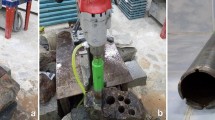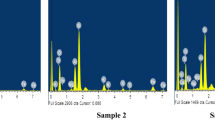Abstract
This paper presents the results of uniaxial compression strength tests performed on samples composed of sandstone and siltstone discs. Samples are loaded until failure, with the aim of determining the dependency between uniaxial compressive strength and the volumetric percentage of siltstone. In order to precisely determine the moment and mechanism of failure of each composite sample, the process was recorded with a high-speed camera (120 fps). Uniaxial compressive strength decreases exponentially with an increase of siltstone volumetric participation. The critical ratio at which the uniaxial compressive strength of the composite sample equals the strength of the uniform siltstone sample was obtained at a siltstone percentage of 60%. The failure mechanism is highly dependent on the siltstone percentage, and occurs as shear or tensile failure, or combined shear-tensile failure in individual discs or throughout the entire composite sample. Comparison of the obtained exponential equation with empirical suggestions shows a good correspondence. It is suspected that the disagreement between the particular conclusions of this study and conclusions of other laboratory studies is due mainly to sample micro-heterogeneity.















Similar content being viewed by others
References
ASTM (2014) Standard test methods for compressive strength and elastic moduli of intact rock core specimens under varying states of stress and temperatures. ASTM designation D-7012
Berisavljević Z, Berisavljević D, Čebašek V (2015) Shear strength properties of Dimitrovgrad flysch, southeastern Serbia. Bull Eng Geol Environ 74(3):759–773. doi:10.1007/s10064-014-0678-5
Eurocode 7, EN1997–2 (2007) Geotechnical design, part 2: ground investigation and testing. European Committee for Standardization, Brussels
Goodman RE (1993) Engineering geology. Wiley, New York, p 412
Greco OD (1994) Behaviour of composite rock specimens under uniaxial compressive tests. Int J Rock Mech Min Sci Geomech Abstr 32(2):A76
Greco OD, Ferrero A, Peila D (1992) Behaviour of laboratory specimens composed of different rocks. In: Proceedings of ISRM international congress on rock mechanics, Aachen, pp 251–245
Huang B, Liu J (2013) The effect of loading rate on the behavior of samples composed of coal and rock. Int J Rock Mech Min Sci 61:23–30
ISRM (2007) The complete ISRM suggested methods for rock characterization, testing and monitoring: 1974–2006. In: Ulusay R, Hudson JA (eds) Suggested methods prepared by the commision on testing methods. International Society for Rock Mechanics Compilation Arranged by the ISRM Turkish National Group Ankara, Turkey
Liang W, Yang C, Zhao Y, Dusseault MB, Liu J (2007) Experimental investigation of mechanical properties of bedded salt rock. Int J Rock Mech Min Sci 44:400–411
Liu J, Wang E, Song D, Wang S, Niu Y (2014) Effect of rock strength on failure mode and mechanical behavior of composite samples. Arab J Geosci. doi:10.1007/s12517-014-1574-9
Marinos P, Hoek E (2001) Estimating the geotechnical properties of heterogeneous rock masses such as flysch. Bull Eng Geol Environ 60:85–92
Saroglou H, Steiakakis C (2010) Prediction of strength of anisotropic and layered flysch-type rocks. In: Proceedings of 6th Hellenic conference on geotechnical engineering, vol 2, Xanthi, Greece, 31 May–2 June 2010, pp 243–249
Tang CA (1997) Numerical simulation of progressive rock failure and associated seismicity. Int J Rock Mech Min Sci 34(2):249–261
Tang CA, Liu H, Lee PKK, Tsui Y, Tham LG (2000) Numerical studies of the influence of microstructure on rock failure in uniaxial compression—part I: effect of heterogeneity. Int J Rock Mech Min Sci 37:555–569
Tziallas GP, Saroglou H, Tsiambao G (2013) Determination of mechanical properties of flysch using laboratory methods. Eng Geol 166:81–89
Zainab M, Kamaruzaman M, Cho Gye C (2007) Uniaxial compressive strength of composite rock material with respect to shale thickness ratio and moisture content. Electron J Geotech Eng 13:1–10.
Author information
Authors and Affiliations
Corresponding author
Rights and permissions
About this article
Cite this article
Berisavljević, Z., Berisavljević, D., Rakić, D. et al. Strength of composite flysch samples under uniaxial compression. Bull Eng Geol Environ 77, 791–802 (2018). https://doi.org/10.1007/s10064-017-1009-4
Received:
Accepted:
Published:
Issue Date:
DOI: https://doi.org/10.1007/s10064-017-1009-4




